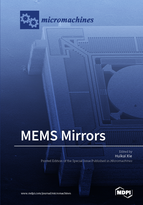MEMS Mirrors
A special issue of Micromachines (ISSN 2072-666X).
Deadline for manuscript submissions: closed (31 March 2017) | Viewed by 109860
Special Issue Editor
Interests: MEMS; CMOS-MEMS sensors; micromirrors; microactuators; piezoelectric MEMS microspeakers; pMUTs; photoacoustic microscopy; optical endomicroscopy
Special Issues, Collections and Topics in MDPI journals
Special Issue Information
Dear Colleagues,
MEMS mirrors can steer, modulate and switch light, as well as control the wavefront for focusing or phase modulation. MEMS mirrors have found enormous commercial success in projectors, displays and fiberoptic communications. Micro-spectrometers based on MEMS mirrors are starting to appear in the consumer market. There are also many breakthroughs in applying MEMS mirrors for endoscopic imaging. Equally excitingly, a new wave of opportunities for MEMS mirrors is coming up, for example, micro-LiDAR for autonomous driving and robotics, optical cross connect (OXC) for cloud data centers, and optical scanners for virtual reality/augumented reality, just to name a few. Of course, there are a number of big challenges that researchers and engineers must overcome to fully utiltize MEMS mirrors’ potential: modeling and control are inherently complex due to the multiphysics, multi-DOF and nonlinear nature of the microactuators for MEMS mirrors; reliability is always a huge hurdle for commercilization; and the tradeoffs among the speed, aperture, and scan range are often overwhelming. Accordingly, this Special Issue seeks to showcase research papers, short communications, and review articles that focus on: (1) novel designs, fabrication, control, and modeling of MEMS mirrors based on all kinds of actuation mechanisms; and (2) new developments of applying MEMS mirrors of any kind in consumer electronics, optical communications, industry, medicine, agriculture, space, or defense.
Prof. Dr. Huikai Xie
Guest Editor
Manuscript Submission Information
Manuscripts should be submitted online at www.mdpi.com by registering and logging in to this website. Once you are registered, click here to go to the submission form. Manuscripts can be submitted until the deadline. All submissions that pass pre-check are peer-reviewed. Accepted papers will be published continuously in the journal (as soon as accepted) and will be listed together on the special issue website. Research articles, review articles as well as short communications are invited. For planned papers, a title and short abstract (about 100 words) can be sent to the Editorial Office for announcement on this website.
Submitted manuscripts should not have been published previously, nor be under consideration for publication elsewhere (except conference proceedings papers). All manuscripts are thoroughly refereed through a single-blind peer-review process. A guide for authors and other relevant information for submission of manuscripts is available on the Instructions for Authors page. Micromachines is an international peer-reviewed open access monthly journal published by MDPI.
Please visit the Instructions for Authors page before submitting a manuscript. The Article Processing Charge (APC) for publication in this open access journal is 2600 CHF (Swiss Francs). Submitted papers should be well formatted and use good English. Authors may use MDPI's English editing service prior to publication or during author revisions.
Keywords
- MEMS mirrors: electrostatic, electromagnetic, electrothermal, piezoelectric, etc.
- Deformable micromirrors
- MEMS mirror arrays
- MEMS mirror modeling
- MEMS mirror control
- MEMS mirror applications:
- Optical communications: OXC, WSS, VOA, LiFi
- Optical imaging
- LiDAR
- Spectrometers
- Displays
- Space
- Other







